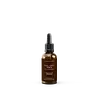What's inside
What's inside
 Key Ingredients
Key Ingredients

 Benefits
Benefits

 Concerns
Concerns

 Ingredients Side-by-side
Ingredients Side-by-side

Water
Skin ConditioningCyclopentasiloxane
EmollientDipropylene Glycol
HumectantDimethicone
EmollientIsononyl Isononanoate
EmollientAdipic Acid/Diglycol Crosspolymer
Dimethicone/PEG-10/15 Crosspolymer
Dimethicone/Vinyl Dimethicone Crosspolymer
Skin ConditioningSqualane
EmollientGlycerin
HumectantBisabolol
MaskingEthylhexylglycerin
Skin ConditioningSodium Chloride
MaskingCaprylic/Capric Triglyceride
MaskingSodium Citrate
BufferingErythorbic Acid
AntioxidantDipotassium Glycyrrhizate
HumectantBHT
AntioxidantRetinol
Skin ConditioningTocopherol
AntioxidantAvena Sativa Kernel Extract
AbrasiveWater, Cyclopentasiloxane, Dipropylene Glycol, Dimethicone, Isononyl Isononanoate, Adipic Acid/Diglycol Crosspolymer, Dimethicone/PEG-10/15 Crosspolymer, Dimethicone/Vinyl Dimethicone Crosspolymer, Squalane, Glycerin, Bisabolol, Ethylhexylglycerin, Sodium Chloride, Caprylic/Capric Triglyceride, Sodium Citrate, Erythorbic Acid, Dipotassium Glycyrrhizate, BHT, Retinol, Tocopherol, Avena Sativa Kernel Extract
Aloe Barbadensis Leaf Juice
Skin ConditioningGlycerin
HumectantPentylene Glycol
Skin ConditioningPropanediol
SolventFructooligosaccharides
HumectantRetinal
Skin ConditioningLecithin
EmollientVaccinium Myrtillus Fruit Extract
Skin ConditioningBeta Vulgaris Root Extract
Skin ConditioningXanthan Gum
EmulsifyingPotassium Lactate
BufferingTocopherol
AntioxidantSodium Citrate
BufferingLactic Acid
BufferingCitric Acid
BufferingSodium Hydroxide
BufferingIngredients Explained
These ingredients are found in both products.
Ingredients higher up in an ingredient list are typically present in a larger amount.
Glycerin is already naturally found in your skin. It helps moisturize and protect your skin.
A study from 2016 found glycerin to be more effective as a humectant than AHAs and hyaluronic acid.
As a humectant, it helps the skin stay hydrated by pulling moisture to your skin. The low molecular weight of glycerin allows it to pull moisture into the deeper layers of your skin.
Hydrated skin improves your skin barrier; Your skin barrier helps protect against irritants and bacteria.
Glycerin has also been found to have antimicrobial and antiviral properties. Due to these properties, glycerin is often used in wound and burn treatments.
In cosmetics, glycerin is usually derived from plants such as soybean or palm. However, it can also be sourced from animals, such as tallow or animal fat.
This ingredient is organic, colorless, odorless, and non-toxic.
Glycerin is the name for this ingredient in American English. British English uses Glycerol/Glycerine.
Learn more about GlycerinSodium Citrate is the sodium salts of citric acid. In skincare, it is used to alter pH levels and acts as a preservative.
Its main functions are to maintain the pH of a product and neutralize metal ions.
The acidity of our skin is maintained by our glands and skin biome; normal pH level of skin is slightly acidic (~4.75-5.5).
Being slightly acidic allows our skin to create an "acid mantle". This acid mantle is a thin barrier that protects our skin from bacteria and contaminants.
Learn more about Sodium CitrateTocopherol (also known as Vitamin E) is a common antioxidant used to help protect the skin from free-radicals and strengthen the skin barrier. It's also fat soluble - this means our skin is great at absorbing it.
Vitamin E also helps keep your natural skin lipids healthy. Your lipid skin barrier naturally consists of lipids, ceramides, and fatty acids. Vitamin E offers extra protection for your skin’s lipid barrier, keeping your skin healthy and nourished.
Another benefit is a bit of UV protection. Vitamin E helps reduce the damage caused by UVB rays. (It should not replace your sunscreen). Combining it with Vitamin C can decrease sunburned cells and hyperpigmentation after UV exposure.
You might have noticed Vitamin E + C often paired together. This is because it is great at stabilizing Vitamin C. Using the two together helps increase the effectiveness of both ingredients.
There are often claims that Vitamin E can reduce/prevent scarring, but these claims haven't been confirmed by scientific research.
Learn more about Tocopherol